Stone Mountain is a quartz monzonite dome monadnock and the site of Stone Mountain Park near Stone Mountain, Georgia. At its summit, the elevation is 1,686 feet (514 m) above sea level and 825 feet (251 m) above the surrounding area. Stone Mountain is well known for not only its geology, but also the enormous rock relief on its north face, the largest bas-relief in the world. The carving depicts three Confederate figures, Jefferson Davis, Robert E. Lee and Stonewall Jackson, and has been the subject of widespread controversy. Stone Mountain was once owned by the Venable Brothers. It was purchased by the State of Georgia in 1958 "as a memorial to the Confederacy." Stone Mountain Park officially opened on April 14, 1965 – 100 years to the day after Lincoln's assassination, although the park had been in use for a few years. It is the most visited destination in the state of Georgia. Stone Mountain is more than 5 miles (8 km) in circumference at its base. The summit of the mountain can be reached by a walk-up trail on the west side of the mountain or by the Skyride aerial tram.
- monzonite
- monadnock
- georgia
1. Geology
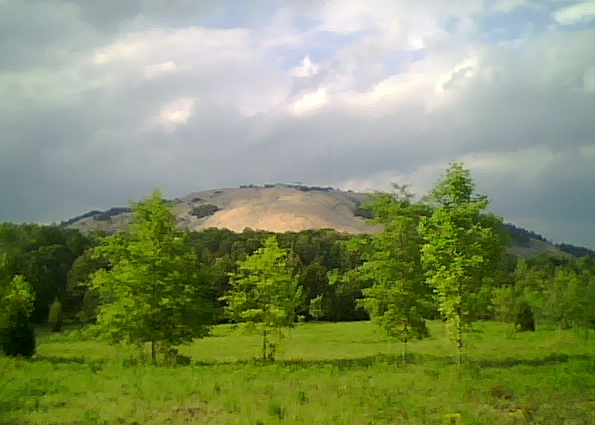
Stone Mountain is a pluton, a type of igneous intrusion. Primarily composed of quartz monzonite, the dome of Stone Mountain was formed during the formation of the Blue Ridge Mountains around 300–350 million years ago (during the Carboniferous period), part of the Appalachian Mountains.[1] It formed as a result of the upwelling of magma from within the Earth's crust. This magma solidified to form granite within the crust five to ten miles below the surface.
The Stone Mountain pluton continues underground 9 miles (14 km) at its longest point into Gwinnett County. Numerous reference books and Georgia literature have dubbed Stone Mountain as "the largest exposed piece of granite in the world".[2] This misconception is most likely a result of misrepresentation by granite companies and early park administration. Stone Mountain, though often called a pink granite dome, actually ranges in composition from quartz monzonite[3] to granite and granodiorite.[4]
The minerals within the rock include quartz, plagioclase feldspar, microcline and muscovite, with smaller amounts of biotite and tourmaline. The tourmaline is mostly black in color, and the majority of it exists as optically continuous skeletal[5] crystals, but much larger, euhedral pegmatitic tourmaline crystals can also be found in the mountain's numerous, cross-cutting felsic dikes. Embedded in the granite are xenoliths or pieces of foreign rocks entrained in the magma.
The granite intruded into the metamorphic rocks of the Piedmont region during the last stages of the Alleghenian Orogeny, which was the time when North America and North Africa collided. Over time, erosion eventually exposed the present mountain of more resistant igneous rock. This intrusion of granite also gave rise to Panola Mountain and Arabia Mountain, both in DeKalb County, smaller outcroppings farther south of Stone Mountain.
2. Natural History
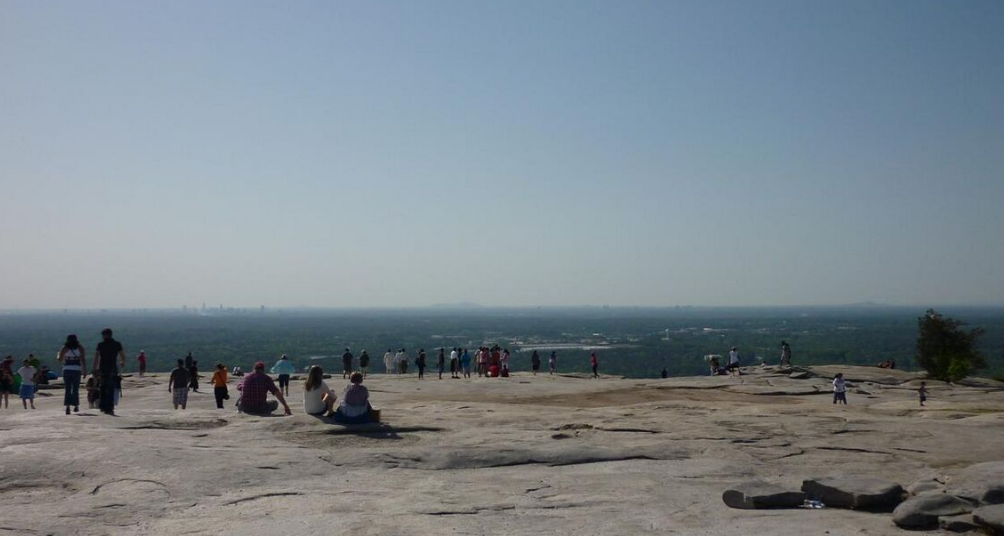
The top of the mountain is a landscape of bare rock and rock pools, and it provides views of the surrounding area including the skyline of downtown Atlanta, often Kennesaw Mountain, and on very clear days even the Appalachian Mountains. On some days, the top of the mountain is shrouded in a heavy fog, and visibility may be limited to only a few feet.
The clear freshwater pools on the summit form by rainwater gathering in eroded depressions, and are home to unusual clam shrimp and fairy shrimp. The tiny shrimp appear only during the rainy season. Through the process of cryptobiosis, the tiny shrimp eggs (or cysts) can remain dormant for years in the dried out depressions, awaiting favorable conditions. These vernal pools are also home to several federally listed rare and endangered plant species, such as black-spored quillwort (Isoetes melanospora) and pool sprite (also called snorkelwort, Gratiola amphiantha).[6][7]
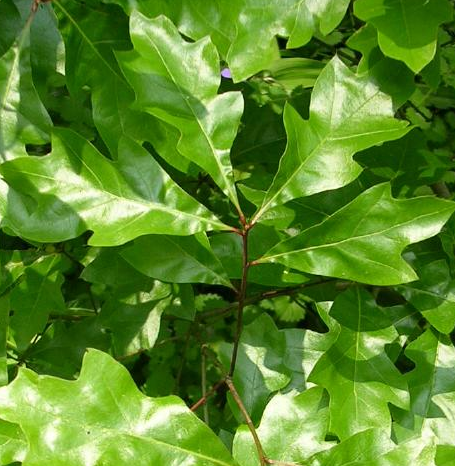
The mountain's lower slopes are wooded. The rare Georgia oak was first discovered at the summit, and several specimens can easily be found along the walk-up trail and in the woods around the base of the mountain. In the fall, the extremely rare Confederate yellow daisy (Helianthus porteri) flowers appear on the mountain, growing in rock crevices and in the large wooded areas. More than 120 wildflowers, most of them native to the Southern Appalachians and including several rare or federally protected species, have been identified on the mountain.[8]
3. Confederate Memorial
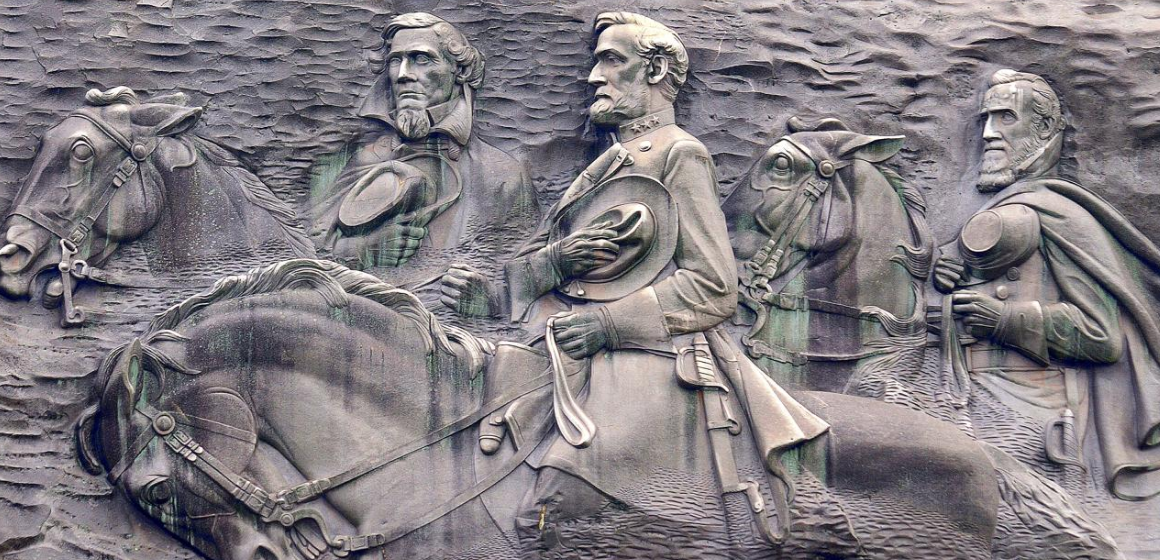
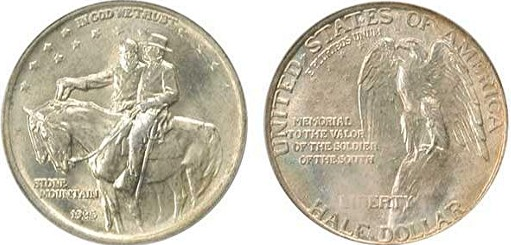

Owned and paid for by the state of Georgia, Stone Mountain is the most-visited tourist attraction in the state.
The largest bas-relief sculpture in the world, the Confederate Memorial Carving depicts three Confederate leaders of the Civil War: President Jefferson Davis and Generals Robert E. Lee and Thomas J. "Stonewall" Jackson (and their favorite horses, "Blackjack", "Traveller", and "Little Sorrel", respectively). The entire carved surface measures 1.57 acres (6,400 m2). The carving of the three men towers 400 feet (120 m) above the ground, measures 76 by 158 feet (23 by 48 m), and is recessed 42 feet (13 m) into the mountain. The deepest point of the carving is at Lee's right elbow, which is 12 feet (3.7 m) into the mountain's surface.[9]
"Who first conceived of a Confederate memorial on the side of Stone Mountain has long been a matter of debate..... The written evidence...points to Francis Ticknor, a nineteenth-century physician and poet from Jones County, Georgia...in an 1869 poem.... William H. Terrell, an Atlanta attorney and son of a Confederate veteran, ...suggested it publicly on May 26, 1914 in an editorial for the Atlanta Constitution."[10]:55 Three weeks later, Georgian John Temple Graves, editor of the New York American, suggested it should have a 70 feet (21 m) statue of Robert E. Lee.[10]:56
The project was greatly advanced by Mrs. C. Helen Plane,[11] a charter member of the United Daughters of the Confederacy (UDC) and first president and Honorary Life President of the Georgia State Division.[10]:57 After obtaining the approval of the Georgia UDC, she set up the UDC Stone Mountain Memorial Association. It was she who chose Gutzon Borglum and invited him to visit the mountain (although, despite his Ku Klux Klan involvement,[10]:79 she "would not shake his hand—he was, after all, a Yankee").[10]:58–59 She met him at the Atlanta train station, took him to the family's summer home, Mont Rest, at the foot of the mountain, and introduced him to Sam Venable,[10]:59 also active in the Klan and owner of the mountain.
Borglum's original plan was spectacular: five groups of figures, sixty-five mounted officers representing the states (to be chosen by the states), General Nathan Bedford Forrest and his cavalry — some 700 to 1,000 figures, each from 35 feet (11 m) to 50 feet (15 m) high. In addition, Borglum planned a room cut 60 feet (18 m) into the mountain, 320 feet (98 m) wide, and 40 feet (12 m) high, faced by 13 columns.[10]:59–60
Venable deeded the north face of the mountain to the UDC in 1916, on condition that it complete a sizeable Civil War monument in 12 years. Finances as well as technical problems slowed progress. The US Mint issued a 1925 Commemorative silver US half dollar, bearing the words "Stone Mountain", as a fundraiser for the monument.[12] This issue, which required the approval of both the 1926 Congress and President Calvin Coolidge, was the largest issue of commemorative coins by the U.S. government up to that time.[10]:81
Financial conflicts between Borglum and the Association led to his firing in 1925.[10]:85 He destroyed his models, claiming that they were his property, but the Association disagreed and had a warrant issued for his arrest. He was warned of the arrest and narrowly escaped to North Carolina, whose governor, Angus McLean, refused to extradite him, [10]:89 though he could not return to Georgia. The affair was highly publicized and there was much discussion and discord, including discord between Sam Venable, the Association, and its president Hollins Randolph.[10]:103, 116–119 The face of Lee that Borglum had partially completed was blasted off the mountain in 1928.[10]:111
Borglum's next major project was Mount Rushmore.
After a number of sculptors turned them down,[10]:97 Augustus Lukeman took up the work in 1925, with a different, smaller design. Fundraising was even more difficult after the public debate and name-calling, and work stopped in 1928. In 1941 segregationist Governor Eugene Talmadge formed the Stone Mountain Memorial Association (SMMA) to continue work on the memorial, but the project was delayed once again by the U.S. entry into World War II (1941–45).[13]
In response to Brown v. Board of Education of 1954 and the birth of the Civil Rights Movement, in 1958, at the urging of segregationist Governor Marvin Griffin,[14]:21 the Georgia legislature approved a measure to purchase Stone Mountain at a price of $1,125,000. In 1963 Walker Hancock was selected to complete the carving, and work began in 1964. The carving was completed by Roy Faulkner, who in 1985 opened the Stone Mountain Carving Museum (now closed) on nearby Memorial Drive commemorating the carving's history.[15] The carving was completed on March 3, 1972.[16] An extensive archival collection related to the project is now at Emory University, with the bulk of the materials dating from 1915 to 1930; the finding aid provides a history of the project, and an index of the papers contained in the collection.[11]
Stone Mountain Park officially opened on April 14, 1965 – 100 years to the day after Lincoln's assassination.[14] Four flags of the Confederacy are flown.[17] The Stone Mountain Memorial Lawn "contains...thirteen terraces — one for each Confederate state.... Each terrace flies the flag that the state flew as member of the Confederacy."[18]
3.1. Involvement of the Ku Klux Klan
Stone Mountain was "the sacred site to members of the second and third national klans."[19]:262
The rebirth of the Ku Klux Klan – the second Klan — was inspired by D. W. Griffith's 1915 Klan-glorifying film, The Birth of a Nation.[20] It was followed in August by the highly publicized lynching of convicted murderer Leo Frank in nearby Marietta, Georgia. On November 25 of the same year, Thanksgiving Day, a small group, including fifteen robed and hooded "charter members" of the new organization, met at the summit of Stone Mountain to create a new iteration of the Klan. They were led by William J. Simmons, and included two elderly members of the original Klan. As part of their ceremony, they set up on the summit an altar covered with a flag, opened a Bible, and burned a 16-foot cross.[14]:20[21]
Stone Mountain was the location of an annual Labor Day cross-burning ceremony for the next 50 years,[22] only ending when the state condemned the property.
Fundraising for the monument resumed in 1923. In October of that year, Venable granted the Klan easement with perpetual right to hold celebrations as they desired.[23] The influence of the UDC continued, in support of Mrs. Plane's vision of a carving explicitly for the purpose of creating a Confederate memorial. She suggested in a letter to the first sculptor, Gutzon Borglum:
The UDC established the Stone Mountain Confederate Memorial Association (SMCMA) for fundraising and on-site supervision of the project. Venable and Borglum, who were both closely associated with the Klan, arranged to pack the SMCMA with Klan members.[24] The SMCMA, along with the United Daughters of the Confederacy, continued fundraising efforts. Of the $250,000 raised, part came from the federal government, which in 1925 issued special fifty-cent coins with the soldiers Robert E. Lee and Stonewall Jackson on them.[25] The image on the verso of the coin was based on "The Last Meeting of Lee and Jackson",[26] executed in 1869 by Everett B. D. Fabrino Julio (American, b. St. Helena 1843 – 1879, emigrated to US 1860), itself an icon of Lost Cause mythology; it is now in the American Civil War Museum (until 2012 the Museum of the Confederacy).[27] When the state completed the purchase in 1960, it condemned the property to void Venable's agreement to allow the Klan perpetual right to hold meetings on the premises.[24]
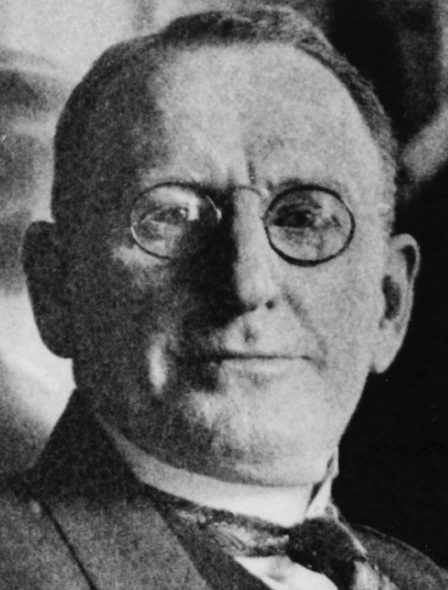
3.2. Confederate Memorial Controversy
After the Charleston church shooting in the summer of 2015, Stone Mountain was the subject of a political debate related to the removal of symbols of the Confederacy.[28] This controversy was stimulated by a movement in other states to remove the Confederate battle flag and statues of Confederate leaders from public areas.
A proposal was made to remove the Confederate carving from Stone Mountain Park.[29] However, according to Georgia state law, no one is allowed to alter the figures carved upon the stone face. Any changes within the state park would require approval by the state legislature.[30]
On October 11, 2015, The Atlanta Journal-Constitution reported the park is considering a proposal of a permanent "Freedom Bell" honoring Martin Luther King, Jr. and the line "Let freedom ring from Stone Mountain of Georgia" as part of King's "I Have a Dream" speech of 1963.[31] The proposed monument is inspired by a bell-ringing ceremony held in 2013 honoring the 50th anniversary of King's speech. It is not supported by the NAACP or King-founded Southern Christian Leadership Conference (SCLC), who want the Confederate symbols removed.[32] Advance Local reported in 2015 that both the DeKalb County branch of the NAACP and the Sons of Confederate Veterans were opposed to the bell because it would have been put next to a Confederate monument. Representatives of the NAACP were quoted by the article saying "It's an attempt to gain support from blacks to keep these racist and demeaning symbols."
In August 2017, after the Unite the Right rally in Charlottesville, Virginia—a white nationalist protest against the removal of the statues of Robert E. Lee and General Stonewall Jackson—turned violent, many people across the country again demanded the removal of many Confederate monuments and memorials as a part of a national political debate.[33][34][35] Georgia State Representative and Democratic gubernatorial candidate Stacey Abrams called for the removal, by sandblasting, of Stone Mountain's carving.[36][37] She called it "a blight upon our state".[38][39]
4. History
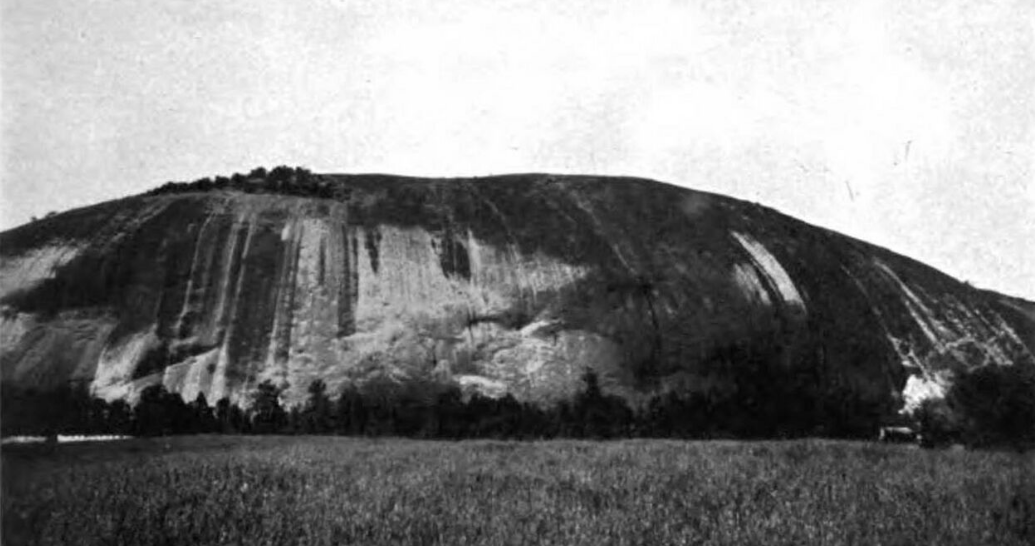
Human habitation of Stone Mountain and its surroundings date back into prehistory. When the mountain was first encountered by European explorers, its summit was encircled by a rock wall, similar to that still to be found on Georgia's Fort Mountain. The wall is believed to have been built by early Native American inhabitants of the area, although its purpose remains unclear. By the beginning of the 20th century, the wall had disappeared, the rocks having been taken away by early visitors as souvenirs, rolled down the rockface, or removed by the commercial quarrying operation. The mountain was the eastern end of the Campbellton Trail, a Native American path that ran through what is now the Atlanta area.
Europeans first learned of the mountain in 1567, when Spanish explorers were told of a mountain farther inland which was "very high, shining when the sun set like a fire." By this time, the Stone Mountain area was inhabited by the Creek and (to a lesser extent) Cherokee peoples.
In the early 19th century, the area was known as Rock Mountain. After the founding of DeKalb County and the county seat of Decatur in 1822, Stone Mountain was a natural recreation area; it was common for young couples on dates to ride to the mountain on horseback. The mountain is easy to climb and there has been a path since the nineteenth century.
Entrepreneur Aaron Cloud built a 165 feet (50 m) wooden observation tower at the summit of the mountain in 1838, but it was destroyed by a storm and replaced by a much smaller tower in 1851. Visitors to the mountain would travel to the area by rail and road, and then walk up the 1.1-mile (1.8 km) mountaintop trail to the top, where Cloud also had a restaurant and club.
Granite quarrying started at Stone Mountain in the 1830s, but became a major industry following the completion of a railroad spur to the quarry site in 1847. This line was rebuilt by the Georgia Railroad in 1869. Over the years, Stone Mountain granite was used in many buildings and structures, including the locks of the Panama Canal, the steps to the East Wing of the United States Capitol and the Imperial Hotel in Tokyo. In recent years, granite suppliers in Georgia sent stone samples cut from Stone Mountain to the Martin Luther King, Jr. Memorial Foundation to be considered for use in a planned monument in King's honor; the foundation later chose to use granite imported from China.[40] Quarrying during earlier periods also destroyed several spectacular geological features on Stone Mountain, such as the Devil's Crossroads, which was located on top of the mountain.
In 1887 Stone Mountain was purchased for $45,000 by the Venable Brothers of Atlanta, who quarried the mountain for 24 more years, and descendants of the Venable family would retain ownership of the mountain until it was purchased by the State of Georgia in the 1950s.
Martin Luther King, Jr. mentioned the monument in his 1963 "I Have a Dream" speech in Washington, D.C., when he said "let freedom ring from Stone Mountain of Georgia!"[41]
During the 1996 Summer Olympics, Stone Mountain Park provided venues for Olympic events in tennis, archery and track cycling.[42][43] The venues for archery and cycling were temporary and are now part of the songbird and habitat trail.[44]
Some of the outdoor scenes for the Netflix series Stranger Things were filmed in the park.[45]
4.1. Aviation Incidents
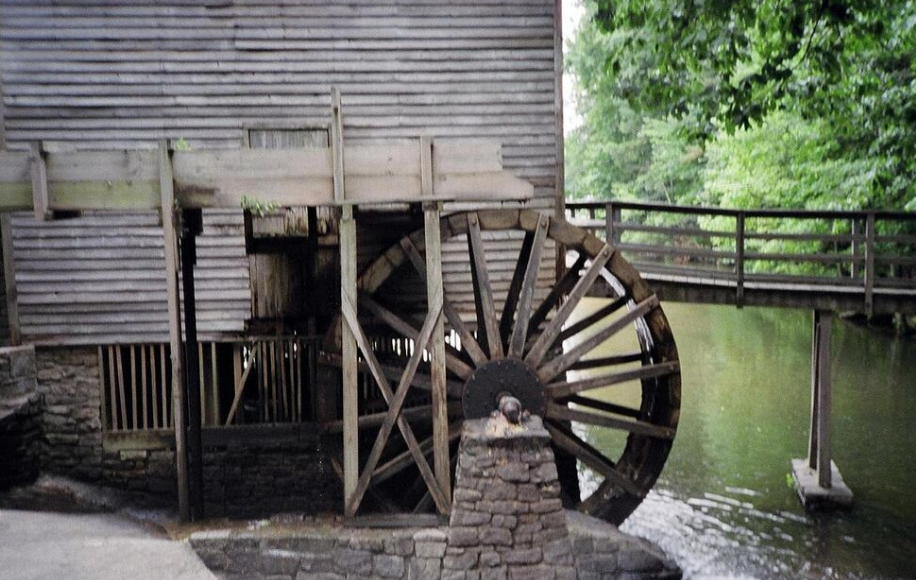
According to George Weiblen's annotated calendar for Monday, May 7, 1928: "Mail plane crashed on mountain at 8:00 P.M." The pilot, Johnny S. Kytle (1905–1931), not only survived the crash, but managed to grab the mail and walk down the mountain.
Around dusk on September 16, 2003, in clear weather, a small airplane circled the mountain five times, crashed headlong into the south side, burst into flames. The pilot was killed. A witness testifying at the NTSB investigation stated that the pilot, a 69-year-old accountant, had threatened on multiple occasions to commit suicide by flying into the mountain. The official NTSB accident report lists the probable cause as "The pilot's intentional flight into the ground for the purpose of suicide while impaired by alcohol."[46]
4.2. Governance
Stone Mountain Park, which surrounds the Confederate Memorial, is owned by the state of Georgia and managed by the Stone Mountain Memorial Association, a Georgia state authority. The Herschend Family Entertainment Corporation currently has a long-term contract to operate park attractions while the Stone Mountain Memorial Association retains ownership and the right to reject any project deemed unfit. Under terms of a 1999 agreement, Norcross, Georgia-based Herschend pays the state of Georgia $11 million annually.[47] Stone Mountain Park is the largest attraction operated by privately held Herschend, which also manages several dozen other attractions including Dollywood in Pigeon Forge, Tennessee, and Silver Dollar City in Branson, Missouri. The company's CEO said in a 2012 news interview that the contract to operate Stone Mountain extended another 35 years.[48]
5. Places of Interest
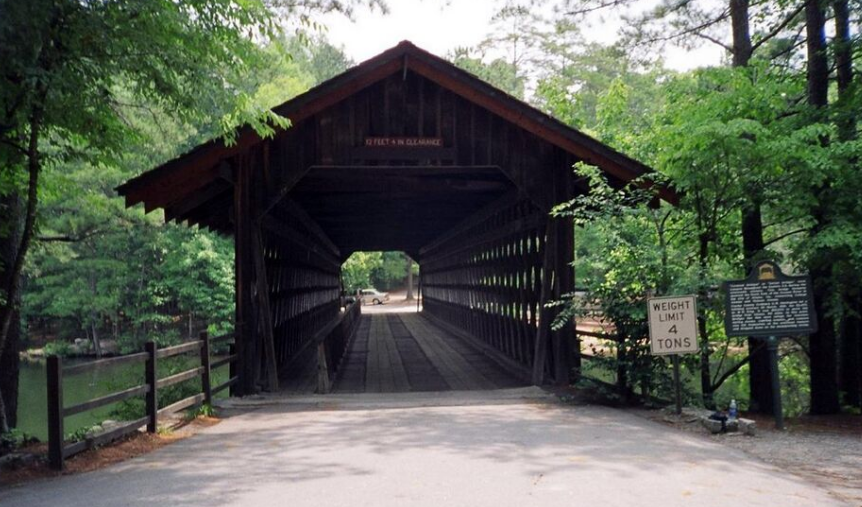
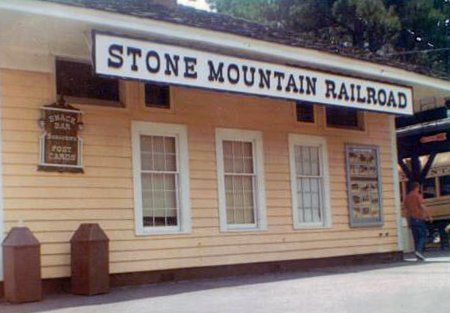

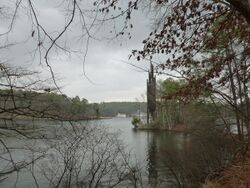

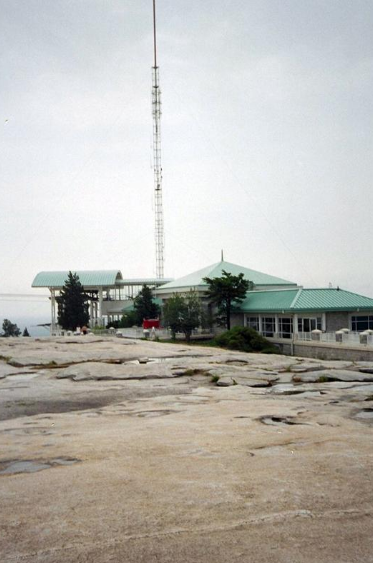

Confederate Hall, operated directly by the Stone Mountain Memorial Association (SMMA), is a museum that educates students and park guests on the geology and ecology of Stone Mountain as well as historical aspects of the area. A small theater shows a historical documentary about the Civil War in Georgia called The Battle for Georgia.
The education department is host to thousands of students each school year, teaching the subjects of geology, ecology, and history. Classes are designed to meet the Georgia Performance Standards and the North American Association for Environmental Education guidelines.
The Antebellum Plantation and Farmyard is an open-air museum composed of 19 historic buildings, built between 1790 and 1875, which have been re-erected on the site to represent a pre-Civil War Georgia plantation. The historic houses have been furnished with an extensive collection of period furniture and decorations. The farm features a petting zoo.
A 732-bell carillon that originated at the 1964 New York World's Fair provides a daily concert.
A covered bridge, dating from 1892, which originally spanned the Oconee River in Athens, Georgia.[49]
A grist mill, dating from 1869 and moved to the park in 1965.
5.1. Broadcast Tower

The short broadcast tower on the top of the mountain transmits two non-commercial stations: television station WGTV TV 8, and weather radio station KEC80 on 162.55 MHz. FM radio station WABE FM 90.1 was located on this tower from 1984 until 2005, when it was required to relocate to accommodate WGTV's digital conversion. W266BW FM 101.1 now has a permit as well. Atop the tower also sits the W4BOC amateur radio repeater, which operates on a frequency of 146.760 mhz.
The tower is also used for the park's Project 25 two-way radio systems.[50][51]
5.2. Stone Mountain Trails
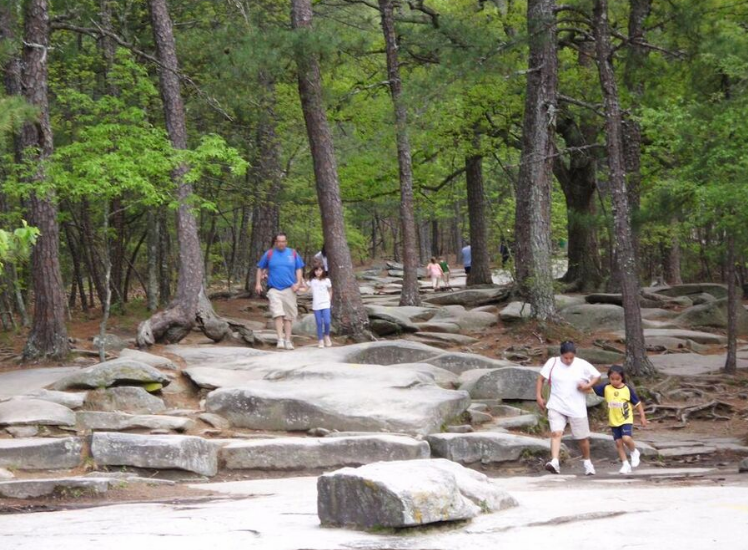
Walk Up Trail: A 1.3-mile (2.1 km) trail to the top of Stone Mountain ascending 786 ft (240 m) in elevation to a height of 1,686 ft (514 m). The trail is steep, but spectacular panoramic views and cool winds await hikers at the top.
Cherokee Trail: A 5-mile (8 km) National Recreation Trail, the Cherokee Trail loops around the mountain base, with a mile section going up and over the west side of the mountain (crosses Walk Up Trail). It passes primarily through an oak-hickory forest, but views of the lakes, streams, and mountain are common.
Nature Garden Trail: A scenic 3⁄4 mile (1.2 km) loop trail through a mature oak-hickory forest community, it is excellent for viewing shade-loving native plants. A small garden with interpretive native plant signs is at the entrance to the trail.
Songbird Habitat Trails: Comprising two loop trails each running 1 mile (1.6 km), the field trail is an excellent birding spot and the woodland trail provides shade and numerous native plants. Dogs are not allowed.
5.3. Attractions
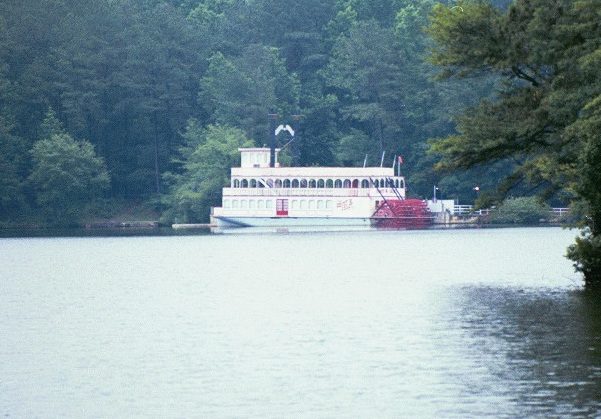
The park features several attractions that are operated by Herschend Family Entertainment Corporation.
On summer evenings the mountain hosts the Stone Mountain Laser Show Spectacular, a fireworks and laser light display. The laser light show projects moving images of the Deep South as well as Georgia history onto the Confederate Memorial carving on the side of the mountain. During Memorial Day Weekend of 2011, Stone Mountain unveiled its overhaul of the laser show, dubbed Mountainvision. This incorporates digital projectors, lasers, special effects, and pyrotechnics.[52]
The Skyride, a Swiss-built cable car to the summit of the mountain, passes by the carving on the way up.
The Riverboat offered a scenic cruise aboard a reproduction of a Mississippi riverboat on 363-acre (147 ha) Stone Mountain Lake. It has been retired.
Historic Square is a collection of historic buildings relocated from around the state of Georgia, including three plantation manor-houses dating from 1794, 1850, and 1845; two slave cabins; a barn; and other outbuildings. The Historic Square Farmyard features historic breeds of sheep, goats, and pigs.
Crossroads is a recreation of an 1872 southern town with several attractions that include a modern 4-D movie theater, an adventure mini-golf course, a duck tour ride. The duck boats have been replaced by the Rockin’ Land and Lake Tour in 2019 due to several deaths in other locations caused by duck boat accidents. The tour includes a ride on a double decker open top bus and a pontoon boat ride at the marina.) stores and restaurants. Craft demonstrators include glass blowing and candy-making.
The Dinotorium is a children's activity area that features 65 interactive games, climbing structures, trampoline floors, and slides.
Sky Hike is a family ropes adventure course.
Geyser Towers is a playground featuring a large fountain at the entrance.
References
- "New Georgia Encyclopedia: Granite Outcrops". Georgiaencyclopedia.org. 2005-01-07. http://www.georgiaencyclopedia.org/nge/Article.jsp?path=/LandResources/Geography/Mountains/SitesandFeatures-1&id=h-2131. Retrieved 2012-12-18.
- Scheffel, Richard L., ed (1980). Natural Wonders of the World. United States of America: Reader's Digest Association, Inc. pp. 358. ISBN 0-89577-087-3.
- Herrmann, L.A. 1954. Geology of the Stone Mountain-Lithonia District, Georgia. Georgia Geological Survey Bulletin 61. Atlanta, GA.
- Grant, W.H. 1962. Field excursion, Stone Mountain-Lithonia district. Georgia Geologic Survey Guidebook 2. Atlanta, Georgia
- Skeletal Tourmaline, Undercooling, and Crystallization History of the Stone Mountain Granite, Georgia, U.S.A., Kristen M. Longfellow and Samuel E. Swanson (incomplete ref)
- "Species Profile for Little amphianthus (Amphianthus pusillus)". https://ecos.fws.gov/ecp0/profile/speciesProfile?spcode=Q1ST.
- "Species Profile for Black Spored quillwort (Isoetes melanospora)". https://ecos.fws.gov/ecp0/profile/speciesProfile?spcode=S015.
- Winslett, Larry and Julie (2004). Wildflowers of Stone Mountain a field guide. Dahlonega, Georgia: Bright Hawk Press. ISBN 0-9755633-0-0.
- Mellen, Mickey (August 19, 2011). "Just how big is the Stone Mountain sculpture?". http://www.gearthblog.com/blog/archives/2011/08/just_how_big_is_the_stone_mountain.html.
- Freeman, David B. (1997). Carved in Stone : The History of Stone Mountain. Mercer University Press. ISBN 0865545472.
- Stone Mountain collection, 1915-1977. Manuscript Collection No. 95. Stuart A. Rose Manuscript, Archives, and Rare Book Library. Emory University. emory.edu. Retrieved 2017-08-25. http://pid.emory.edu/ark:/25593/8zxfs
- Pilitowski, Tom. "Information about the Stone Mountain Half Dollar coin" (in English). http://www.usrarecoininvestments.com/collecting/stone-mountain-halfdollar.htm.
- Stewart, Bruce E. (2004). "Stone Mountain". New Georgia Encyclopedia. http://www.georgiaencyclopedia.org/articles/geography-environment/stone-mountain. Retrieved June 4, 2018.
- McKinney, Debra (Spring 2018). "Stone Mountain. A Monumental Dilemma". Southern Poverty Law Center Intelligence Report (164): 18–22.
- Pousner, Howard (June 16, 1985). "Stone Mountain's mass appeal also brings some tall problems". Atlanta Journal-Constitution. https://www.ajc.com/entertainment/attractions/stone-mountain-mass-appeal-also-brings-some-tall-problems/KvzUEjSDMfBbchHQfwNoWM/. Retrieved May 25, 2018.
- "History". Stone Mountain Park. stonemountainpark.org. http://www.stonemountainpark.com/About/History. Retrieved 2017-08-25.
- Davis, Mark (July 2, 2015). "Flag causes flap at Stone Mountain". Atlanta Journal-Constitution. https://www.myajc.com/news/flag-causes-flap-stone-mountain/gzL67vy49V0RZU2yajcnzN/. Retrieved May 25, 2018.
- Corson, Pete. "Photos: Confederate memorials in metro Atlanta". Atlanta Journal-Constitution. https://www.myajc.com/news/local/photos-confederate-memorials-metro-atlanta/4GRL1pq5JCvgl14heVFn8J/#p4n7UtNgEeaaFysXpM96yA. Retrieved May 25, 2018.
- Loewen, James W. (1999). Lies Across America: What our Historic Sites Get Wrong. The New Press. ISBN 1565843444.
- "A Painful Present as Historians Confront a Nation's Bloody Past". Hartford-hwp.com. http://www.hartford-hwp.com/archives/45a/316.html. Retrieved 2014-07-29.
- "The Various Shady Lives of the Ku Klux Klan". Time (magazine). April 9, 1965. http://www.time.com/time/magazine/article/0,9171,898581,00.html. "An itinerant Methodist preacher named William Joseph Simmons started up the Klan again in Atlanta in 1915. Simmons, an ascetic-looking man, was a fetishist on fraternal organizations. He was already a "colonel" in the Woodmen of the World, but he decided to build an organization all his own. He was an effective speaker, with an affinity for alliteration; he had preached on "Women, Weddings and Wives," "Red Heads, Dead Heads and No Heads," and the "Kinship of Kourtship and Kissing." On Thanksgiving Eve 1915, Simmons took 15 friends to the top of Stone Mountain, near Atlanta, built an altar on which he placed an American flag, a Bible and an unsheathed sword, set fire to a crude wooden cross, muttered a few incantations about a "practical fraternity among men," and declared himself Imperial Wizard of the Invisible Empire of the Knights of the Ku Klux Klan."
- Petrella, Christopher (March 30, 2016). "On Stone Mountain". Boston Review. https://bostonreview.net/us/christopher-petrella-stone-mountain-white-supremacy-modern-democratic-party.
- Patsy Sims (1996). The Klan. University Press of Kentucky. p. 247. ISBN 0-8131-0887-X. https://books.google.com/books?id=2-84635lwKYC&pg=PA247.
- "Stone Mountain Carving". Ngeorgia.com. http://ngeorgia.com/ang/Stone_Mountain_Carving. Retrieved 2014-07-29.
- Shaff, Howard & Audrey arl Shaff, Six Wars at a Time: the life and times of Gutzon Borglum, Sculptor of Mt. Rushmore, The Center For Western Studies, Sioux Falls, South Dakota, 1985 p. 207
- "Confederate Half Dollar". http://xroads.virginia.edu/~ug97/stone/coin.html. Retrieved 1 September 2017.
- "The Last Meeting". https://www.encyclopediavirginia.org/media_player?mets_filename=evm00001209mets.xml.
- "Debate brewing over Stone Mountain Park's Confederate flags". http://www.wsbtv.com/news/news/local/debate-brewing-over-stone-mountain-parks-confedera/nmnWd/. Retrieved 2015-08-11. .
- "NAACP calls for removal of giant Confederate carving on Georgia mountainside". Retrieved 2016-07-23. https://www.rt.com/usa/273721-naacp-georgia-confederate-monument/
- "The removal of the Confederate carving at Stone Mountain is seen as unlikely". http://www.onlineathens.com/mobile/2015-07-25/removal-confederate-carving-stone-mountain-seen-unlikely. Retrieved 2015-07-26. "
- "A monument to MLK will crown Stone Mountain - Political Insider blog". http://politics.blog.ajc.com/2015/10/11/a-monument-to-mlk-will-crown-stone-mountain/. Retrieved 1 September 2017.
- Suggs, Ernie (October 15, 2015). "Civil rights groups oppose King monument on Stone Mountain". Atlanta Journal-Constitution. https://www.myajc.com/news/civil-rights-groups-oppose-king-monument-stone-mountain/iqH55iW9CnU7eiW5oVIWDN/. Retrieved May 25, 2018.
- Schachar, Natalie (August 15, 2015). "Jindal seeks to block removal of Confederate monuments in New Orleans". Los Angeles Times. http://www.latimes.com/nation/nationnow/la-na-nn-jindal-monuments-20150814-story.html. Retrieved August 17, 2017.
- Kenning, Chris (August 15, 2017). "Confederate Monuments Are Coming Down Across the United States". The New York Times. https://www.nytimes.com/interactive/2017/08/16/us/confederate-monuments-removed.html.
- "U.S. cities step up removal of Confederate statues, despite Virginia". Reuters. August 16, 2017. https://www.reuters.com/article/us-virginia-protests-statues-idUSKCN1AV0XE.
- "The Week: After Charlottesville, eyes turn to Stone Mountain". August 18, 2017. http://www.ajc.com/news/state--regional-govt--politics/the-week-after-charlottesville-eyes-turn-stone-mountain/kR4u7ofQmbQxF82DrFbmeK/.
- Sack, Kevin; Blinder, Alan (July 28, 2018). "In Georgia Governor's Race, a Defining Moment for a Southern State". New York Times. https://www.nytimes.com/2018/07/28/us/politics/georgia-governor-race.html.
- Fausset, Richard (October 18, 2018). "Stone Mountain: The Largest Confederate Monument Problem in the World". New York Times. https://www.nytimes.com/2018/10/18/us/stone-mountain-confederate-removal.html.
- Shah, Khushbu (October 24, 2018). "The KKK’s Mount Rushmore: the problem with Stone Mountain". The Guardian. https://www.theguardian.com/cities/ng-interactive/2018/oct/24/stone-mountain-is-it-time-to-remove-americas-biggest-confederate-memorial.
- Democracy in America American politics (August 30, 2011). "Martin Luther King: A blockheaded memorial". The Economist. https://www.economist.com/blogs/democracyinamerica/2011/08/martin-luther-king. Retrieved 2012-12-18.
- King, Martin Luther, Jr (28 August 1963). "I have a Dream". Lillian Goldman Law Library. http://avalon.law.yale.edu/20th_century/mlk01.asp. Retrieved 8 October 2011. "let freedom ring from Stone Mountain of Georgia!"
- 1996 Summer Olympics official report. Volume 1. p. 543. http://www.la84foundation.org/6oic/OfficialReports/1996/1996v1.pdf
- 1996 Summer Olympics official report. Volume 3. pp. 448, 453. http://www.la84foundation.org/6oic/OfficialReports/1996/1996v3.pdf
- Driving Map: Stone Mountain Park (2009). Pamphlet. Stone Mountain, Georgia: Stone Mountain Park.
- "Georgia Locations for Netflix's 'Stranger Things'". Deep South Media. July 28, 2016. http://deepsouthmag.com/2016/07/28/georgia-locations-for-netflixs-stranger-things/. "Georgia's small towns outside of Atlanta, including Douglasville, Conyers, Jackson, Winston and Fayetteville, easily pass for the Midwest, and Jackson's intact downtown isn't a far stretch from 1983 Hawkins on film."
- NTSB Accident Report: Stone Mountain , 16 September 2003. https://ntsb.gov/ntsb/brief.asp?ev_id=20030922X01565
- Woods, Walter (31 May 2003). "New CEO hopes to boost Stone Mountain crowds". https://www.bizjournals.com/atlanta/stories/2003/03/31/story5.html.
- Bill Hendrick, For the AJC. "Stone Mountain Park owner: ‘We’re 50% bigger than 10 years ago’" (in English). https://www.ajc.com/business/stone-mountain-park-owner-bigger-than-years-ago/zfETCkZ27Br0r5VgE7vRUL/.
- Seibert, David. "Stone Mountain Covered Bridge". Digital Library of Georgia. http://georgiainfo.galileo.usg.edu/topics/historical_markers/county/dekalb/untitled-stone-mountain-covered-bridge. Retrieved 15 November 2016.
- Stone Mountain Park Memorial Association system: WPRF799 (public safety) FCC website http://wireless2.fcc.gov/UlsApp/UlsSearch/license.jsp?licKey=1302090&__newWindow=false
- Stone Mountain Park Memorial Association system: WNAU431 (businesses) FCC website http://wireless2.fcc.gov/UlsApp/UlsSearch/license.jsp?licKey=1126604&__newWindow=false:
- "Stone Mountain Park Debuts New Lasershow Spectacular™ in Mountainvision This Summer – STONE MOUNTAIN, Ga., March 21, 2011 /PRNewswire/". Prnewswire.com. 2011-03-21. http://www.prnewswire.com/news-releases/stone-mountain-park-debuts-new-lasershow-spectacular-in-mountainvision-this-summer-118359159.html. Retrieved 2014-07-29.
